| IMPERIAL CLASSICAL ROME |
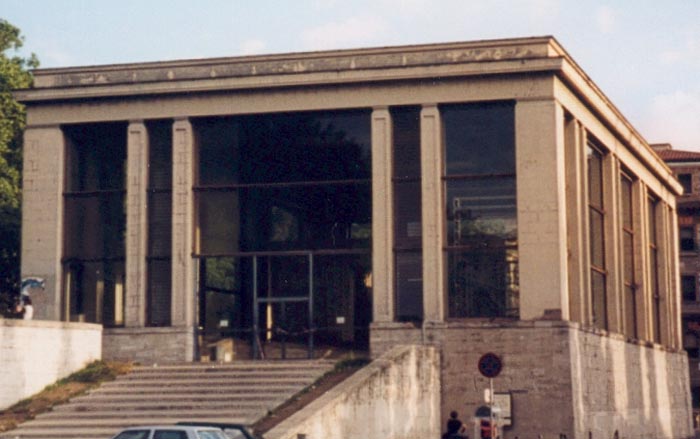 |
Ara Pacis - Imperial Rome The Ara Pacis (Altar of Peace) is one of the most significant monuments of ancient rome. It celebrates the peace created throuhgout the Mediterranean area by Emperor Augustus. Commissioned by the Senate in 13BC and completed 4 years later. All the surfaces are decorated with magnificent friezes and reliefs carved in Carrara marble. |
 |
Colosseum - Imperial Rome |
 |
Imperial Rome Rome's greatest amphitheater was commissioned by the Emperor Vespasian in AD72. Deadly gladiatorial cobats and wild animal rights were staged free of charge by the emperor and wealthy citizens for public viewing. |
 |
Forum - Imperial Rome The Colosseum was built to a practical design, with 80 arched entrances allowing easy access to 55,000 spectators. Several similar amphitheaters were built by the Romans (in El Djem in North Africa, Nimes and Arles in France and Verona in Italy). |
 |
Forum - Imperial Rome In 69AD Vespasian a professional soldier became emperor, founded the Flavian dynasty and commissioned the Colosseum in 72AD. In 96 the Colosseum was completed. In 248 there was a 1000th year founding of rome celebration here. In 404 Gladiatorial combats were banned and in 442 it was damaged by an earthquake. 523 Wild animal fights were banned. |
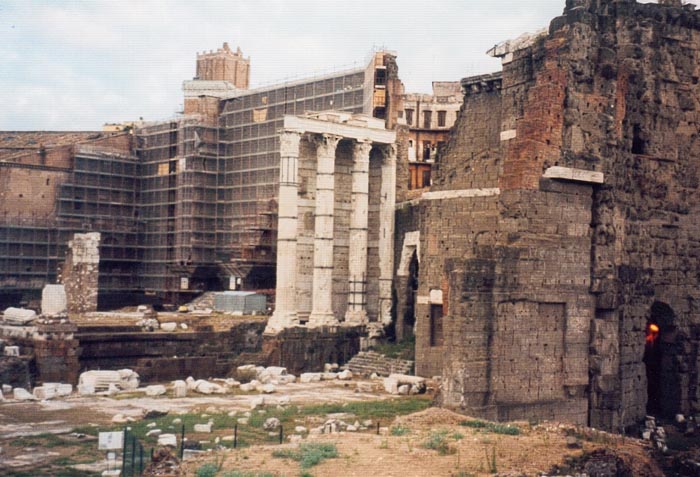 |
Forum - Imperial Rome This temple is dedicated to Minerva. She was Domitian's protective divinity and had survived in good condition until 1606 when Pope V had it destroyed so the materials could be used to build the Fountain di acqua Paola sul gianicolo. Excavations in 1995 show that it was located in an area destroyed by a terrible fire in 64BC. |
 |
Forum - Imperial Rome The forum was the center of political, commercial and judicial life in ancient Rome. The largest buildings were Basilicas. The area teamed with lawyers and litigants, bankers and brokers, shopkeepers and strumpets (according to Plautus). Rome's population boomed, and the Forum became too small. In 46 BC Julius Caesar built a new one. |
 |
Forum - Imperial Rome This is the Temple of Antonius and Faustina. It was first dedicated in 141AD by Emperor Antoninus Pius to his late wife Faustina, the temple was rededicated to them both on the death of the emperor. |
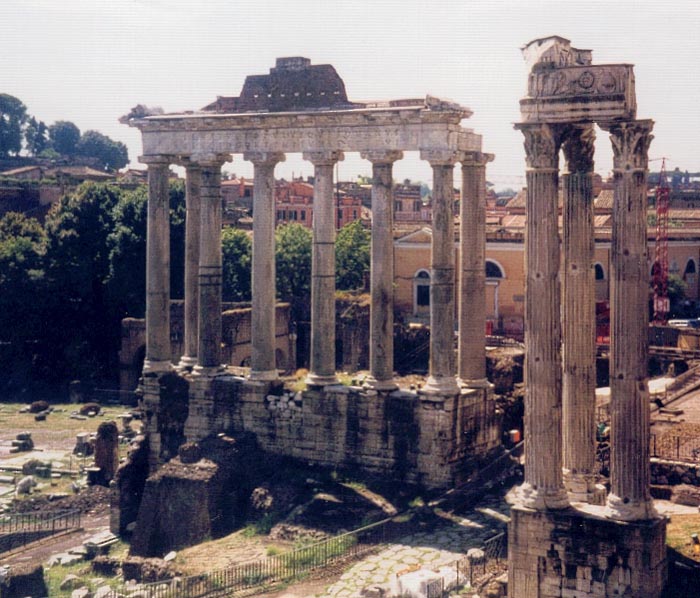 |
Forum - Imperial Rome These eight surviving columns are from the Temple of Saturn and the 3 colums from the Temple of Vespasian. It is the oldest temple in the Forum, it was first opened in 498BCE. It is located in the west end of the Forum. There were three temples dedicated to Saturn at the Forum. the first built in the last years of the Roman Kingdom. It is a Etruscan style architecture. The first temple was torn down in 42BCE and a new temple built in stone was built but destroyed by a fire in 283CE. This destroyed major parts of the Forum. It was reconstructed under Diocletian after the fire. The temple was of Ionic order. These 8 surviving columns are of red and grey granite. The inscription reads "Senatus Populusque romanus incendio consumptum restituit", meaning "The Roman senate and people restored what fire had consumed". An altar dedicated to Saturn, stood in front of the temple. |
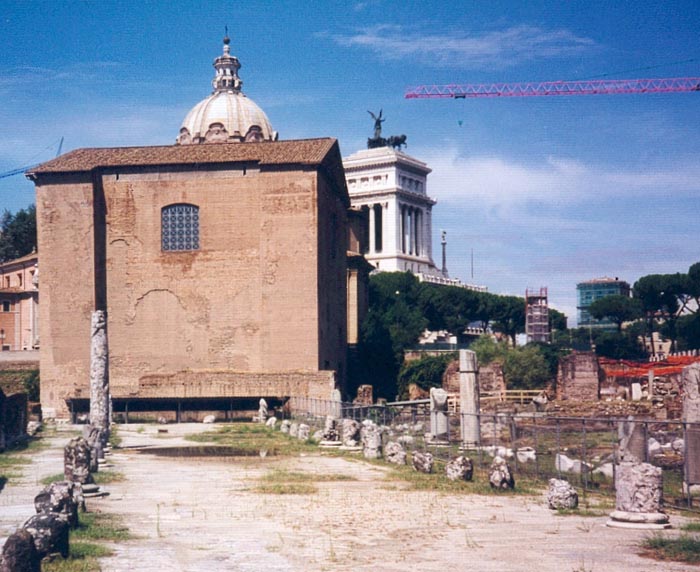 |
Forum - Imperial Rome This is the Curia, where Rome's Senate (chief council of state) used to meet. It is a modern replica of the ancient building. It original was destoyed by fire in 52BC, Julius Caesar built a new one and was destroyed by a fire in 94AD. Domitian build a new one in 3rd century. Right next to this is the Rostra, where speeches were deliverd. The most famous being Mark Antony's "Friends, Romans, and countrymen" oration after the assassination of Julius Caesar in 44BC. Next year, Cicero's heads and hands were put on display after he had been put to death by the second triumvirate. The dais took its name from the ships' prows (rostrA) with which it was decorated. Sheathed in iron (for ramming), these prows had been captured at the Battle of Antium in 4th century BC. |
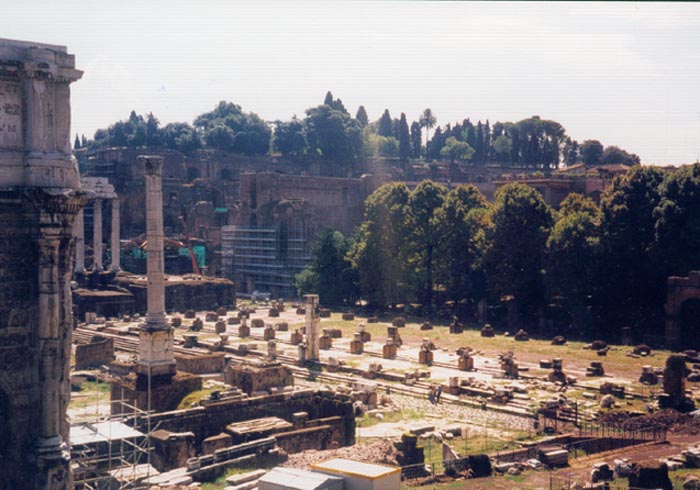 |
Forum - Imperial Rome This immense hall was the Basilica Julia, named after Julius Caesar, who ordered its construction, the basilica housed important law courts. It was begun in 54BC and completed afte rCaesar's death. It was damaged by fire in 9BC and repaired. the Basilica had a central hall measuring 260 feet by 59 feet. |
 |
Forum - Imperial Rome The Temple of Saturn |
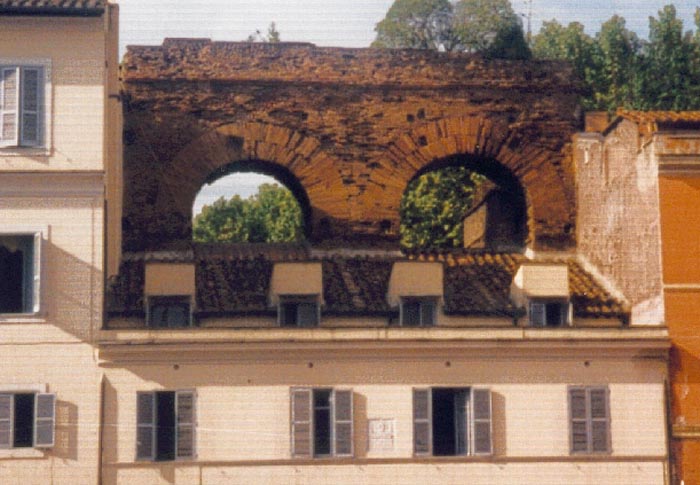 |
Nero's Aqueduct - Imperial Rome
The aqueduct was built for Nero in the 1st century AD, and was an extension of the Aqua claudia. It was later extended to supply the Imperial residences on the Palatine. Partly incorporated into later buildings, the imposing arches make their way via the Lateran to the celian hill. |
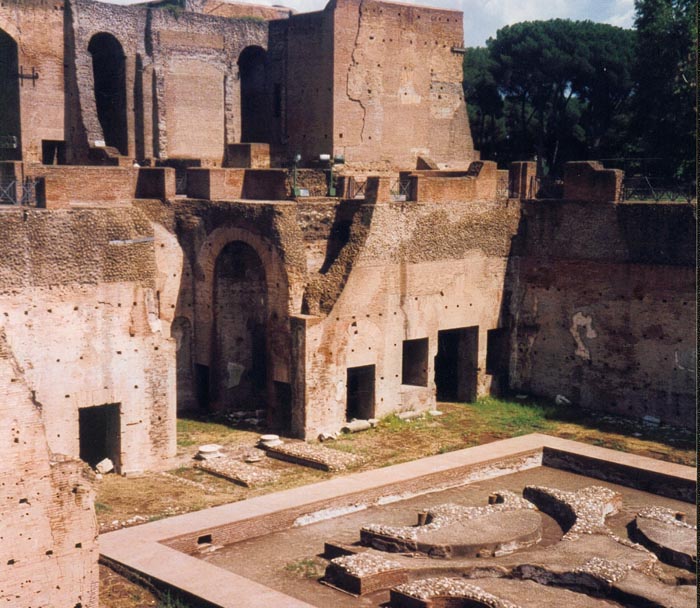 |
Palatine - Imperial Rome According to Legend, Romulus and remus were raised here in Palatine by a Wolf in a cave. |
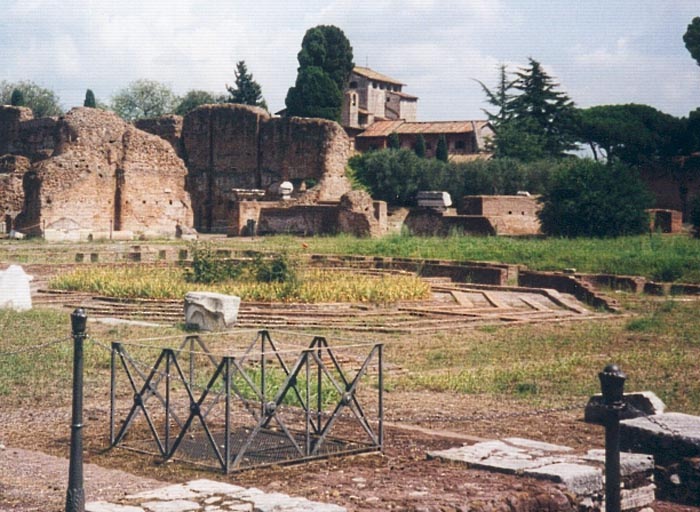 |
Palatine - Imperial Rome Traces of Iron Age huts from the 9th Century BC, have been found on Palatine Hill, providing archaeological support for the area's legendary links with the founding of Rome. second wife, are among the best preserved. |
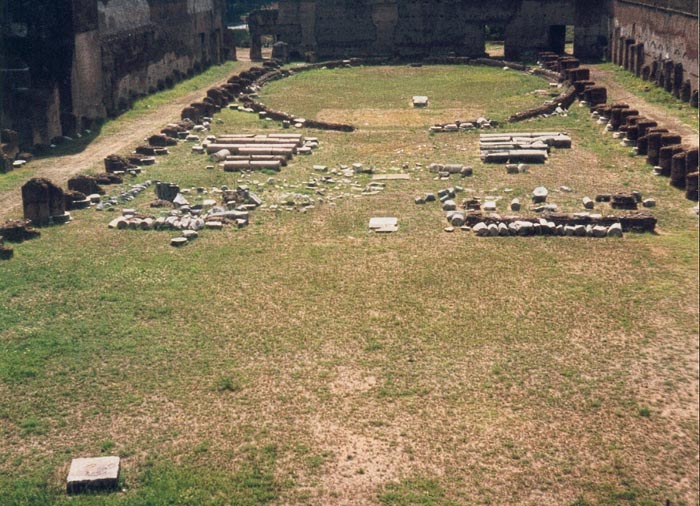 |
Palatine - Imperial Rome It was a desirable place to live and was home to some of the city's most famous people. Cicero, Catullus and Augustus lived here. The two buildings identified as the House of Augustus and the House of Livia, his |
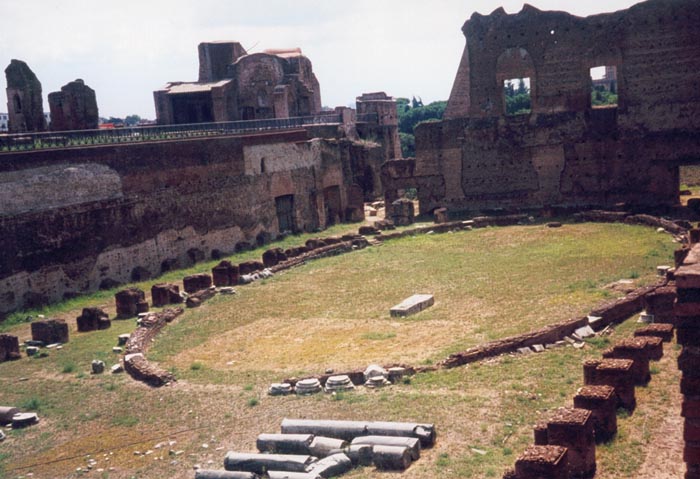 |
Palatine - Imperial Rome This is a picture of the Stadium and laid out at the same time as the palace of Domitian. It is not clear whether it was a public stadium, private track or large garden. The alcove in the eastern wall looks as though it may have held a box from which the emperor could have watched races. |
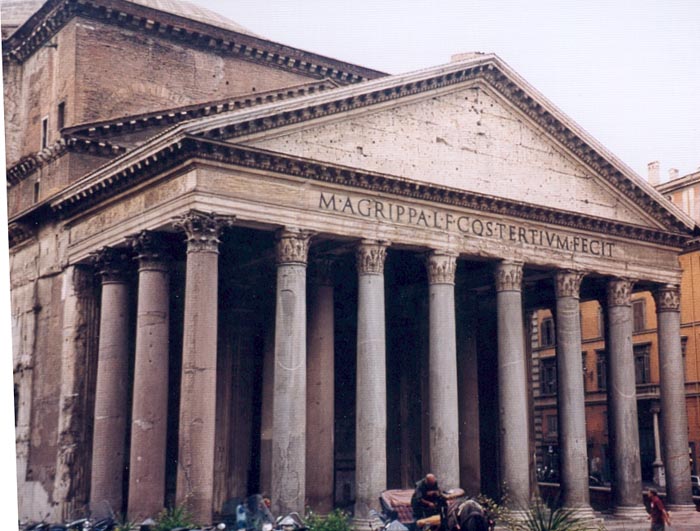 |
Pantheon - Imperial Rome The Pantheon - the roman "temple of all the gods". In the middle ages, this magnificent building with its awe-inspiring domed interior became a symbol of Rome itself. The rectangular portico screens the vast hemispherical dome. Only from inside can its true scale and beauty be appreciated. The rotunda's height and diameter are equal 140 feet (43.3 meters) |
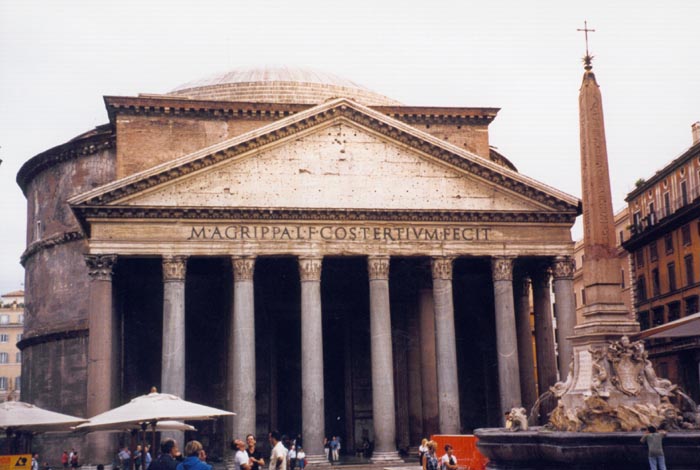 |
Pantheon - Imperial Rome The opening at the top of the dome, the oculus, provides the only light. We owe this marvel of Roman engineering to Emperor Hadrian. He designed it to replace an earlier temple built by Marcus Agrippa, son-in-law of Augustus. |
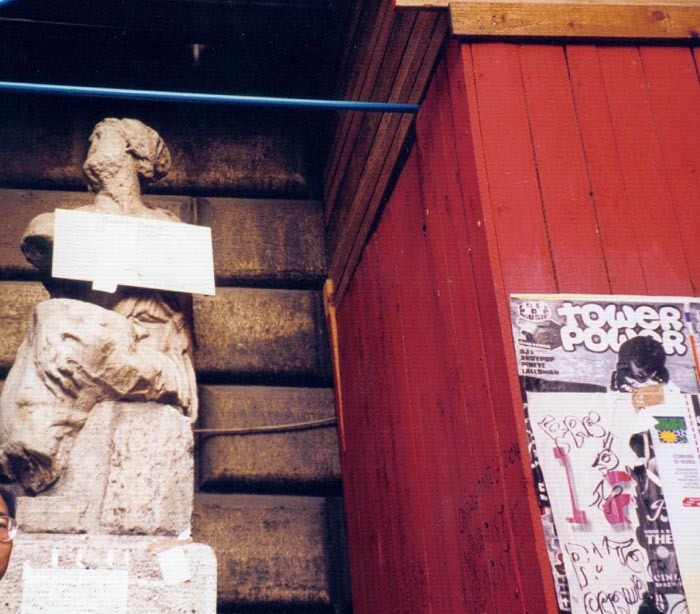 |
Pasquino - Imperial Rome This rough chunk of marble is all the remains of a Hellenistic group, representing the incident in Homer's Iliad where Menelaus shields the body of the slain Patroclus. For years it lay as a stepping stone in a muddy medieval street until it was erected in 1501 near the shop of an outspoken cobbler named Pasquino. Freedom of speech was not encouraged in papal Rome, so the cobbler wrote out his satirical comments on current events and attached them to this statue. Other Romans were quick to follow suit, hanging maxims and verses on the status by night to escape punishment. The sayings of the talking status were part of popular culture right up until the 19th century. Other statues started to "talk" in the same satirical vein. |
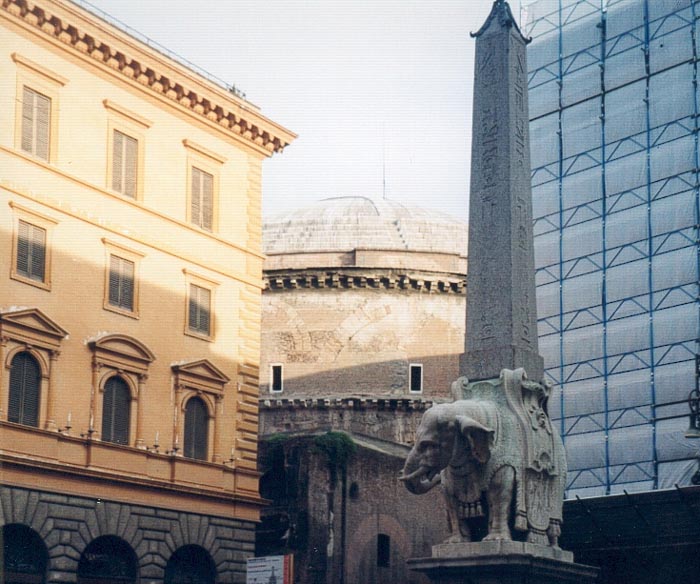 |
Piazza de Minerva this is the Bernini's elephant fountain in Piazza Minerva. |
 |
Ponte Rotto - Imperial Rome Ponte Rotto, simply means "broken bridge" and was built in the 2nd century BC, and originally named the Pons Aemilius. |
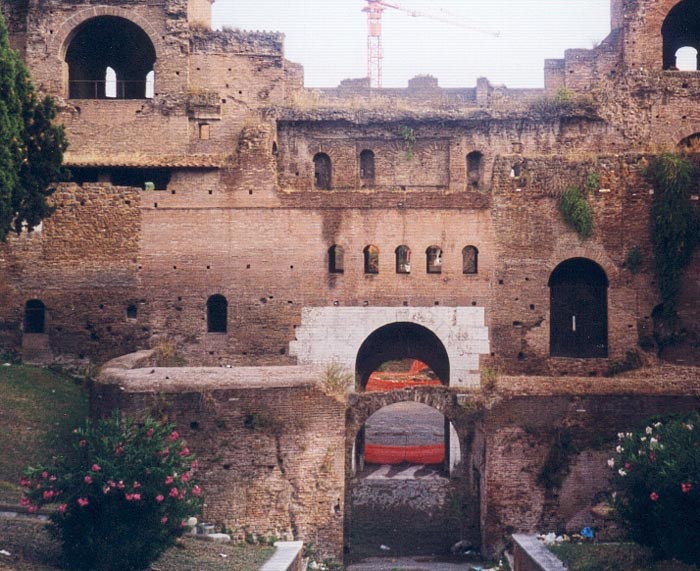 |
Porta Asinarius - Imperial Rome
Porta Asinaria (Gate of the Donkeys) is one of the minor gateways in the aurelian Wall. Two circular towers were added. In 546 AD treacherous barbarian soldiers serving in the roman army opened this gate to the hordes of the goth Totila, who mercilessly looted the city. In 1084, the Holy roman Emperor Henry IV entered Rome via Porta Asinaria with the antipop Guibert to oust Pope gregory VII. The gateway was damaged by the pope's rescuer, the Norman robert Guiscard, who set the whole area around San Giovanni in Laterano on fire. |
 |
Santa Maria (Trestevere) This was probably the first official christian place of worship built in rome, the basilica became the focus of devotion to the virgin Mary. According to legend, the church was founded by Pope callixtus I in the 3rd century, when Christianity was still a minority cult. Today's church is largely a 12th century building. The 22 granite columns in the nave were taken from the ruins of ancient Roman buildings. Despite some 18th century Baroque additions, Santa Maria has retained it medieval character. |
 |
Trajan's Market - Imperial Rome
Trajan's Market - Originally considered among the wonders of the classical world, Trajan's markets now show only a hint of their former splendor. Emperor Trajan and his architect, Apollodorus of damascus, built this visionary new complex of 150 shops and offices (probably used for administering the corn ration) in the early 2nd century AD. |
 |
Trajan's Market - Imperial Rome
Trajan's Market - It was the ancient roman equivalent of the modern shopping center, selling everything from silks and spices imported from the Middle East to fresh fish, fruit and flowers. Trajan's market was built in 112AD. In 117 Trajan Died. In 472 Ricimer the Suevian invaded rome and station troops here. in 552, Byzantine took over rome and the market was used by them. |
 |
Via Appia - Imperial Rome Via Appia Antica - The first part of the Via appia was built in 312BC by Appius claudius Caecus. It was extended to the ports of Benevento, Taranto and brindisi in 190BC. The road became Rome's link with its expanding empire in the East. it was the route taken by the funeral processions of the dictator Sulla (78BC) and emperor Augustus (14AD). It was gradually abandoned during the Middle Ages, the road was restored in the mid-16th century by Pope Pius IV. It is lined with ruined family tombs and the collective burial places known as columbaria. |